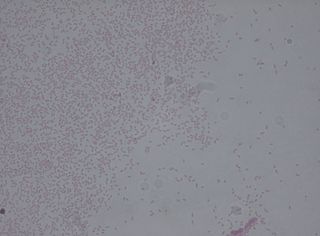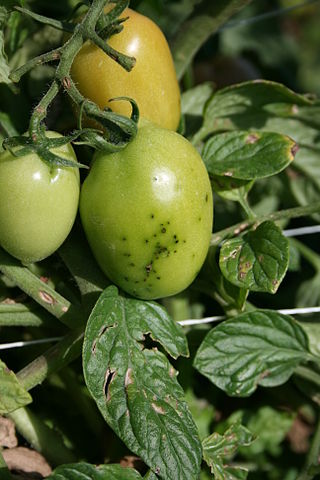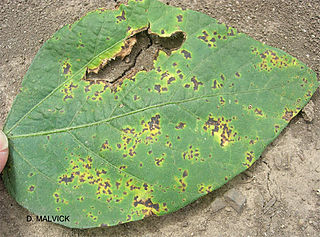
A plant canker is a small area of dead tissue, which grows slowly, often over years. Some cankers are of only minor consequence, but others are ultimately lethal and therefore can have major economic implications for agriculture and horticulture. Their causes include a wide range of organisms as fungi, bacteria, mycoplasmas and viruses. The majority of canker-causing organisms are bound to a unique host species or genus, but a few will attack other plants. Weather and animal damage can also cause stress to the plant resulting in cankers. Other causes of cankers is pruning when the bark is wet or using un-sterilized tools.
Phytotoxins are substances that are poisonous or toxic to the growth of plants. Phytotoxic substances may result from human activity, as with herbicides, or they may be produced by plants, by microorganisms, or by naturally occurring chemical reactions.

Xanthomonas campestris is a gram-negative, obligate aerobic bacterium that is a member of the Xanthomonas genus, which is a group of bacteria that are commonly known for their association with plant disease. This species includes Xanthomonas campestris pv. campestris the cause of black rot of brassicas, one of the most important diseases of brasicas worldwide.

Pseudomonas syringae is a rod-shaped, Gram-negative bacterium with polar flagella. As a plant pathogen, it can infect a wide range of species, and exists as over 50 different pathovars, all of which are available to researchers from international culture collections such as the NCPPB, ICMP, and others.
Pseudomonas avellanae is a Gram-negative plant pathogenic bacterium. It is the causal agent of bacterial canker of hazelnut. Based on 16S rRNA analysis, P. avellanae has been placed in the P. syringae group. This species was once included as a pathovar of Pseudomonas syringae, but following DNA-DNA hybridization, it was instated as a separate species. Following ribotypical analysis Pseudomonas syringae pv. theae was incorporated into this species.

Pseudomonas cichorii is a Gram-negative soil bacterium that is pathogenic to plants. It has a wide host range, and can have an important economical impact on lettuce, celery and chrysanthemum crops. P. cichorii was first isolated on endives, from which it derives its name. It produces 6-aminopenicillanic acid. Based on 16S rRNA analysis, P. cichorii has been placed in the P. syringae group.

Pseudomonas savastanoi is a gram-negative plant pathogenic bacterium that infects a variety of plants. It was once considered a pathovar of Pseudomonas syringae, but following DNA-relatedness studies, it was instated as a new species. It is named after Savastano, a worker who proved between 1887 and 1898 that olive knot are caused by bacteria.
Pseudomonas viridiflava is a fluorescent, Gram-negative, soil bacterium that is pathogenic to plants. It was originally isolated from the dwarf or runner bean, in Switzerland. Based on 16S rRNA analysis, P. viridiflava has been placed in the P. syringae group. Following ribotypical analysis misidentified strains of Pseudomonas syringae pv. ribicola and Pseudomonas syringae pv. primulae were incorporated into this species. This pathogen causes bacterial blight of Kiwifruit.
Pseudomonas amygdali is a Gram-negative plant pathogenic bacterium. It is named after its ability to cause disease on almond trees. Different analyses, including 16S rRNA analysis, DNA-DNA hybridization, and MLST clearly placed P. amygdali in the P. syringae group together with the species Pseudomonas ficuserectae and Pseudomonas meliae, and 27 pathovars of Pseudomonas syringae/Pseudomonas savastanoi, constituting a single, well-defined phylogenetic group which should be considered as a single species. This phylogenetic group has not been formally named because of the lack of reliable means to differentiate it phenotypically from closely related species, and it is currently known as either genomospecies 2 or phylogroup 3. When it is formally named, the correct name for this new species should be Pseudomonas amygdali, which takes precedence over all the other names of taxa from this group, including Pseudomonas savastanoi, which is and inadequate and confusing name whose use is not recommended.

Pseudomonas cannabina is a gray, Gram-negative, fluorescent, motile, flagellated, aerobic bacterium that causes leaf and stem rot of hemp, from which it derives its name. It was formerly classified as a pathovar of Pseudomonas syringae, but following ribotypical analysis, it was reinstated as a species. The type strain is CFBP 2341.
Pseudomonas tremae is a white, Gram-negative, non-fluorescent, motile, flagellated, aerobic bacterium that infects Trema orientalis, from which it derives its name. It was formerly classified as a pathovar of Pseudomonas syringae, but following ribotypical analysis, it was instated as a species. The type strain is CFBP 3229.

Xanthomonas is a genus of bacteria, many of which cause plant diseases. There are at least 27 plant associated Xanthomonas spp., that all together infect at least 400 plant species. Different species typically have specific host and/or tissue range and colonization strategies.

Pantoea agglomerans is a Gram-negative bacterium that belongs to the family Erwiniaceae.

Halo blight of bean is a bacterial disease caused by Pseudomonas syringae pv. phaseolicola. Halo blight’s pathogen is a gram-negative, aerobic, polar-flagellated and non-spore forming bacteria. This bacterial disease was first discovered in the early 1920s, and rapidly became the major disease of beans throughout the world. The disease favors the places where temperatures are moderate and plentiful inoculum is available.

"Pseudomonas tomato" is a Gram-negative plant pathogenic bacterium that infects a variety of plants. It was once considered a pathovar of Pseudomonas syringae, but following DNA-relatedness studies, it was recognized as a separate species and several other former P. syringae pathovars were incorporated into it. Since no official name has yet been given, it is referred to by the epithet 'Pseudomonas tomato' .
"Pseudomonas helianthi" is a Gram-negative plant pathogenic bacterium that infects a variety of plants. It was once considered a pathovar of Pseudomonas syringae, but following DNA-relatedness studies, it was recognized as a separate species and P. syringae pv. tagetis was incorporated into it, as well. Since no official name has yet been given, it is referred to by the epithet 'Pseudomonas helianthi' .

Tabtoxin, also known as wildfire toxin, is a simple monobactam phytotoxin produced by Pseudomonas syringae. It is the precursor to the antibiotic tabtoxinine β-lactam (TBL). It is produced by:
Bleeding canker of horse chestnut is a common canker of horse chestnut trees that is known to be caused by infection with several different pathogens.

The rsmX gene is part of the Rsm/Csr family of non-coding RNAs (ncRNAs). Members of the Rsm/Csr family are present in a diverse range of bacteria, including Escherichia coli, Erwinia, Salmonella, Vibrio and Pseudomonas. These ncRNAs act by sequestering translational repressor proteins, called RsmA, activating expression of downstream genes that would normally be blocked by the repressors. Sequestering of target proteins is dependent upon exposed GGA motifs in the stem loops of the ncRNAs. Typically, the activated genes are involved in secondary metabolism, biofilm formation and motility.

Bacterial blight of soybean is a widespread disease of soybeans caused by Pseudomonas syringaepv. glycinea.












